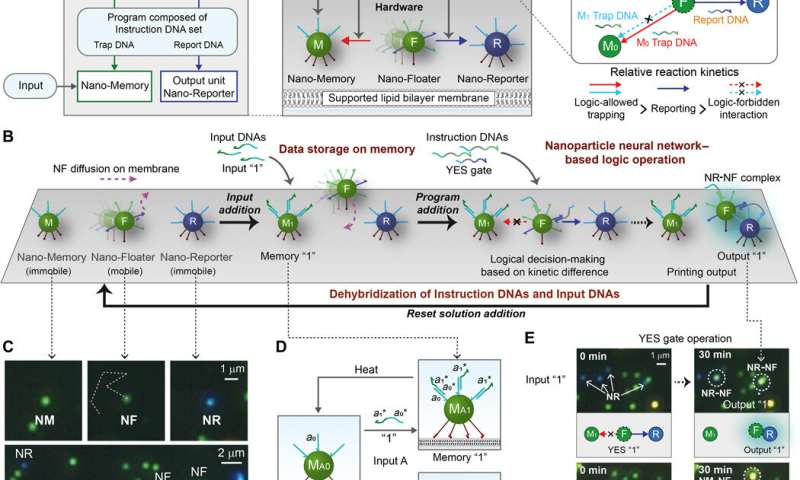HOME
Nanoparticle-based computing architecture for nanoparticle neural networks

The nanoparticle-based von Neumann architecture (NVNA) on a lipid nanotablet (LNT) chip. (A) Schematic of NVNA-LNT. The LNT is operated with software composed of Instruction DNAs in solution and hardware composed of nanoparticles on a lipid bilayer. The hardware consists of a data storage unit, NM; an output unit, NR; and a processing unit, NF. A set of Instruction DNAs programs logic operation using a kinetic difference between nanoparticle reactions with memory storage state. (B) LNT protocol: (i) data storage on NM, (ii) neural network (NNN) operation by Instruction DNA set addition, and (iii) reset by dehybridizing DNAs for the next executions. (C) Time-lapse dark-field microscopic imaging can differentiate each nanoparticle on LNT via scattering color and mobility. The non-labeled nanoparticles are NM. (D) Molecular information storage on the NM changes the exposed single-stranded domain. (E) YES, gate operation results. Input “1” results in output “1,” printing the NF-NR. Otherwise, all NFs are trapped to NM and exhibit no reaction on NR, which is output “0.” Credit: Science Advances, doi: 10.1126/sciadv.abb3348
Scalable nanoparticle-based computing architectures have several limitations that can severely compromise the use of nanoparticles to manipulate and process information through molecular computing schemes. The von Neumann architecture (VNA) underlies the operations of multiple arbitrary molecular logic operations in a single chip without rewiring the device. In a new report, Sungi Kim and a team of scientists at the Seoul National University in South Korea developed the nanoparticle-based VNA (NVNA) on a lipid chip. The nanoparticles on the lipid chip functioned as the hardware—featuring memories, processors and output units. The team used DNA strands as the software to provide molecular instructions to program the logic circuits. The nanoparticle-based von Neuman architecture (NVNA) allowed a group of nanoparticles to form a feed-forward neural network known as a perceptron (a type of artificial neural network). The system can implement functionally complete Boolean logical operations to provide a programmable, resettable and scalable computing architecture and circuit board to form nanoparticle neural networks and make logical decisions. The work is now published on Science Advances.
Electronic computers of the past could only run a fixed program and researchers had to physically rewire and restructure processes to reprogram such machines. The von Neumann architecture (VNA) developed by John von Neumann in 1945 and later cited by Alan Turing in his proposal for the automatic computing engine, details a stored-program computer to execute a set of instructions. The system processed information by sequentially fetching the stored data and instructions from the memory to generate outputs. The powerful programmability of the VNA is applicable for modern computers and in quantum computing.
Molecular computing with nanostructures can allow a variety of technologies such as nanoparticle logic gates, single-molecule biosensors and logic sensing, although such systems are limited to a single program much like early electronic computers. The limits arose since researchers incorporated the software (function) and nanostructural hardware as a single unit. To overcome this challenge, they can include lipid bilayers to compartmentalize molecules and nanoparticles. Kim et al. had previously developed a computing platform with nanoparticles on a lipid bilayer to form a nano-bio-computing lipid nanotablet (LNT). In this work, they designed and realized a nanoparticle-based von Neuman architecture (NVNA) platform for molecular computing on a lipid nanotablet (LNT).
News Source